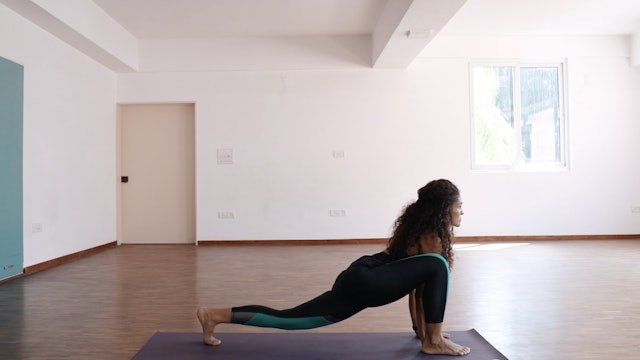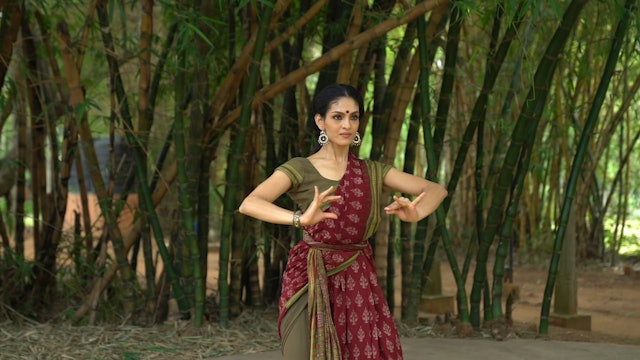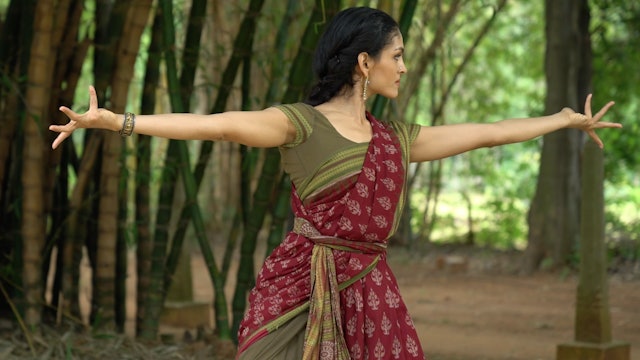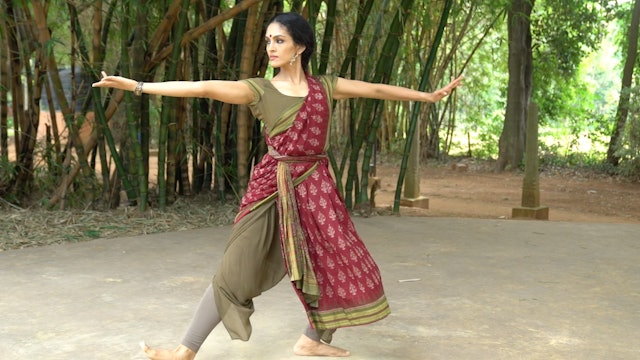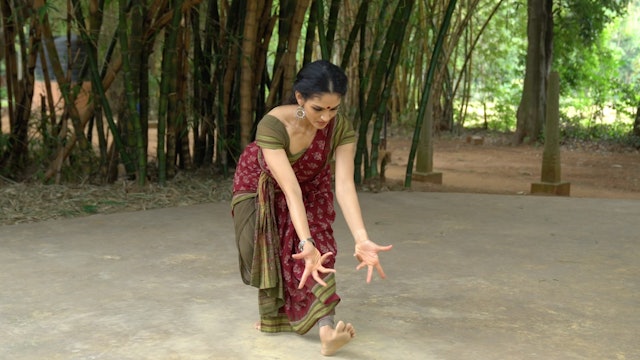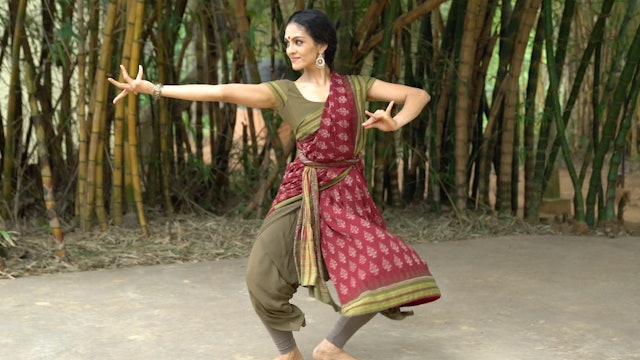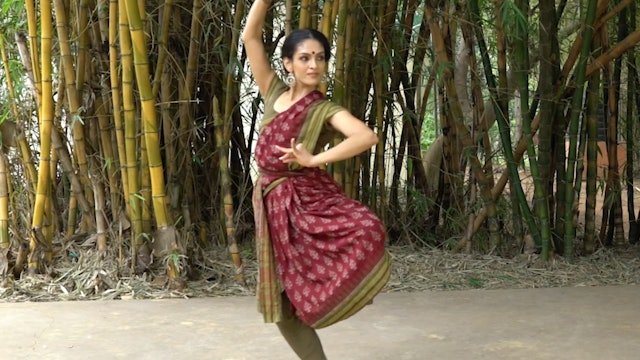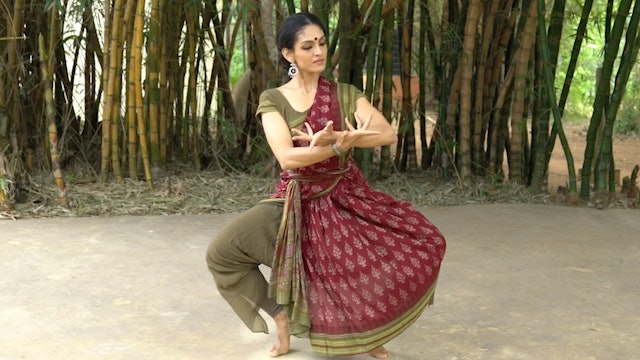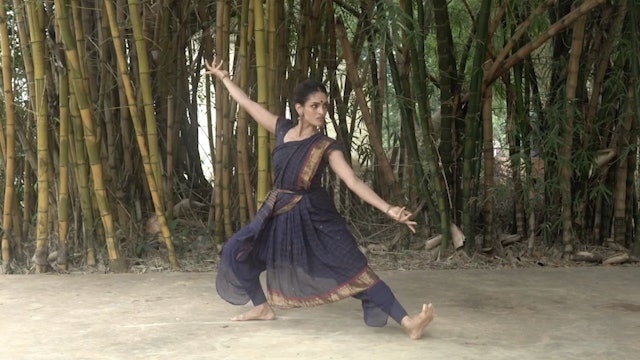-
Musical Warm-up 3
This Warm-up series reinforces ideas that have already been introduced in the previous instructed series. It is recommended to start on the musical warm-ups only once you have practised the instructed series over several months, so you already have internal awareness of alignment.
-
Arms in front of chest
The positions of the arms are often neglected, without attention to the correct muscular engagement. This series will introduces various usages of the arms in exercises and Bharatanatyam and go through systematically how the position and engagement of muscles should be in each scenario.
Where ar...
-
Aramandi Dynamic 1
This series utilises the basic Araimandi position and guides the dancer into movement in a systematic and precise fashion so that the Adavus thereafter get more clarity and precision. This also greatly helps in injury prevention and adds a second layer of understanding to the Adavus already learned.
-
Aramandi Dynamic 6 (to Swastikam)
This series utilises the basic Araimandi position and guides the dancer into movement in a systematic and precise fashion so that the Adavus thereafter get more clarity and precision. This also greatly helps in injury prevention and adds a second layer of understanding to the Adavus already learned.
-
Arms moving in various directions
The positions of the arms are often neglected, without attention to the correct muscular engagement. This series will introduces various usages of the arms in exercises and Bharatanatyam and go through systematically how the position and engagement of muscles should be in each scenario.
This vid...
-
Pakkadavu 1
Pointers for Pakkadavu 1:
Watch the level of your arms. Make sure you maintain the length of your neck. Turn to the side with your head straight, without tilting. Keep your eyeballs in the centre of your eyes. When you reach to the side, do not raise the opposite elbow. maintain length.
The ...
-
Pakkadavu 2
Pointers for Pakkadavu 2:
Keep your shoulders down when stretching your arms.
Keep the height of the arm that you are looking away from. It is common to let this arm go too far back or let it drop below shoulder height.
Keep your head straight when you look to the side.
Make sure you keep you... -
The Natyarambha Position
The positions of the arms are often neglected, without attention to the correct muscular engagement. This series will introduces various usages of the arms in exercises and Bharatanatyam and go through systematically how the position and engagement of muscles should be in each scenario.
What is ...
-
Aramandi Dynamic 3 (Naatadavu)
This series utilises the basic Araimandi position and guides the dancer into movement in a systematic and precise fashion so that the Adavus thereafter get more clarity and precision. This also greatly helps in injury prevention and adds a second layer of understanding to the Adavus already learned.
-
The Natyarambha Position: Flipping the elbow
The positions of the arms are often neglected, without attention to the correct muscular engagement. This series will introduces various usages of the arms in exercises and Bharatanatyam and go through systematically how the position and engagement of muscles should be in each scenario.
What is ...
-
Naatadavu 1
This Adavu has a stretching action in the leg where the foot is flexed and the heel is placed on the floor. The alignment of the hip bones is important in this. The turn-out and stability in the Araimandi position of the dancer must have developed by the time he/she starts the Naatadavu. If this ...
-
Aramandi Dynamic 4 (front Naatadavu)
This series utilises the basic Araimandi position and guides the dancer into movement in a systematic and precise fashion so that the Adavus thereafter get more clarity and precision. This also greatly helps in injury prevention and adds a second layer of understanding to the Adavus already learned.
-
Naatadavu 3
The third Naatadavu stretches the leg out to the front. If you are unable to keep your back straight when doing this, please refer to the flexibility section and practice the tips for forward bends and try again.
-
Aramandi Dynamic 7 ( to Vaiśnavstānam)
This series utilises the basic Araimandi position and guides the dancer into movement in a systematic and precise fashion so that the Adavus thereafter get more clarity and precision. This also greatly helps in injury prevention and adds a second layer of understanding to the Adavus already learned.
-
Circular arm movement: Up to Down
The positions of the arms are often neglected, without attention to the correct muscular engagement. This series will introduces various usages of the arms in exercises and Bharatanatyam and go through systematically how the position and engagement of muscles should be in each scenario.
How do w...
-
Paraval Adavu 1
Paraval literally means to spread. Some schools of thought also call the Paraval adavu, the 'Pakkadavu' as it moves to the side while sliding. Some others change the name based on the way the foot articulates with the floor. A few of the types of Paraval, can be referred to as Marditam adavau, as...
-
Aramandi Dynamic 8 ( to Ūrdvajānu)
This series utilises the basic Araimandi position and guides the dancer into movement in a systematic and precise fashion so that the Adavus thereafter get more clarity and precision. This also greatly helps in injury prevention and adds a second layer of understanding to the Adavus already learned.
-
Circular arm movement: Down to Up
The positions of the arms are often neglected, without attention to the correct muscular engagement. This series will introduces various usages of the arms in exercises and Bharatanatyam and go through systematically how the position and engagement of muscles should be in each scenario.
How do w...
-
Pakkadavu 4
Pointers for Pakkadavu 4:
- Keep your shoulders down when lifting your arm.
- Make sure your arm in front of your chest doesn't cross the centre of your chest.
- Make sure you do not sit in your hip when lifting one leg. Keep the thigh pushing back on the standing leg
- do not rest your raised ... -
Aramandi Dynamic 2
This series utilises the basic Araimandi position and guides the dancer into movement in a systematic and precise fashion so that the Adavus thereafter get more clarity and precision. This also greatly helps in injury prevention and adds a second layer of understanding to the Adavus already learned.
-
The Natyarambha Position: Turning forward
The positions of the arms are often neglected, without attention to the correct muscular engagement. This series will introduces various usages of the arms in exercises and Bharatanatyam and go through systematically how the position and engagement of muscles should be in each scenario.
How do w...
-
Kuditta Mettaduvu
Pointers for Kuditta Mettadavu:
Try to go down instead of hopping up each time you snatch onto your heels.
Keep dropping your tailbone and pushing your thighs back.
When you bend to the side, try not to have any form of a forward bend.By the time you progress to the Kuditta mettadavu, your l...
-
Arms into a torqued diagonal
The positions of the arms are often neglected, without attention to the correct muscular engagement. This series will introduces various usages of the arms in exercises and Bharatanatyam and go through systematically how the position and engagement of muscles should be in each scenario.
The two ...
-
Serikal Adavu Variation 2
"Serikal", means to slide. This series of Adavus include a variety of sliding movements in the Adavu series of The Raadha Kalpa Method. The first variety is introduced in this series. Technically 'Jaaru' and 'Serikal' mean the same thing, but we will call this second series of sliding Adavus as '...


